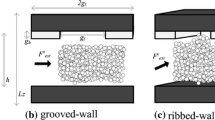Abstract
The sub-laminar drag effect of microgroove surfaces was studied numerically in a steady two-dimensional channel flow at subcritical Reynolds numbers. Considerations are restricted to grooves of a few viscous length scales in depth, which are assumed not to promote the laminar to turbulent transition process. It was found that the drag reduction effect is due to the layout of grooves with respect to the flow direction and contour geometry. Results of computations show that for grooves of curved contour placed normal to the flow direction, drag arising from viscous and pressure forces is modulated due to the functional dependence of forces on the surface area projected in the flow direction. Such a groove layout leads to a large skin-friction reduction, but a comparable increase in pressure drag results in sub-laminar drag if drag over flat surface is considered as a reference. For a curved groove contour, the drag reduction increases with increasing Reynolds number and reaches about 5 % at Reynolds numbers approaching critical.
















Similar content being viewed by others
References
Alireza M, Floryan JM (2011) Flow in grooved micro-channels. In: Proceedings of the seventh symposium on turbulence and shear flow phenomena (http://www.tsfp7.org), Ottawa, Canada
Choi H, Moin P, Kim J (1991) On the effect of riblets in fully developed laminar channel flow. Phys Fluids 3:1892
Choi H, Moin P, Kim J (1993) Direct numerical simulation of turbulent flow over riblets. J Fluid Mech 255:503–539
Comet-Version 2.00 User Manual (2001) Institute of Computational Continuum Mechanics, Hamburg
Daschiel G (2010) Sub-laminar drag in a two-dimensional channel flow. Diplomarbeit, Institute of Fluid Mechanics, University Erlangen-Nuremberg
Djenidi L, Anselmet F, Liandrat J, Fulachier L (1994) Laminar boundary layer over riblets. Phys Fluids 6:2993–3000
Dovgal AV, Levchenko V Y, Timofeev V A (1989) Boundary layer control by local heating of the wall. In: Arnal D, Michael R (eds) Laminar-turbulent transition. Springer, Berlin, pp 193–121
Ferzinger JH, Perić M (2001) Computational methods for fluid dynamics, 3rd edn. Springer, Berlin
Friedmann E (2010) The optimal shape of riblets in the viscous sublayer. J Math Fluid Mech 12:243–265
Gad-el-Haak M (2000) Flow control: passive, active and reactive flow management. Cambridge University Press, Cambridge
Garimella G (2009) Personal communication. Technische Universität Darmstadt
Gatski TB, Grosch CE (1985) Embedded cavity drag in steady laminar flow. AIAA J 23:1028–1037
Ghaddar NK, Korczak KZ, Mikić BB, Patera AT (1986) Numerical investigation of incompressible flow in grooved channels. Part 1. Stability and self-sustained oscillations. J Fluid Mech 163:99–127
Hage W (2005) Zur Widerstandsverminderung von dreidimensionalen Riblet-Strukturen und anderen Oberflähen. Mensch and Buch Verlag
Jovanović J, Frohnapfel B, Srikantharajah R, Jovanović Dj, Linhart H, Delgado A (2011) Microflow-based control of near-wall fluctuations for large viscous drag reduction. Microfluids Nanofluids 11:733-780
Jung YC, Bhushan B (2010) Biomimetic structures for fluid drag reduction in laminar and turbulent flows. J Phys Condens Matter 22:1–9
Lang AW, Johnson TJ (2010) Drag reduction over embedded cavities in Couette flow. Mech Res Commun 37:432–435
Lammers P, Jovanović J, Durst F (2006) Numerical experiments on wall turbulence at low Reynolds numbers. J Thermal Sci 10:33–62
Lumley JL (1977) Drag reduction in two phase flows. Phys Fluids 20:64–71
Metzner AB (1977) Polymer solution and fiber suspension rheology and their relationship to turbulent drag reduction. Phys Fluids 20:145–149
Pfenninger W (1961) Transition experiments in the inlet length of tubes at high Reynolds numbers. In: Lachmann Gv (ed) Boundary layer and flow control, vol 2. Oxford University Press, Oxford, pp 970–980
Schlichting H (1968) Boundary-layer theory, 6th edn. Mc-Graw Hill, New York
Scholle M, Rund H, Aksel N (2005) Drag reduction and improvement of material transport. Arch Appl Mech 75:93–112
Sternberg J (1952) A free-flight investigations of the possibility of high Reynolds number supersonic boundary layers. J Aeronaut Sci 19:721–733
Toms BA (1949) Some observations on the flow of linear polymer solutions through straight tubes at large Reynolds numbers. Proceedings of international congress on rheology, vol 2. North-Holland, Amsterdam, pp 135–141
Walsh MJ (1983) Riblets as a drag reduction technique. AIAA 21:485
Zakin JL, Lu B, Bewersdorff HW (1998) Surfactant drag reduction. Rev Chem Eng 14:253–320
Acknowledgments
This work was initially sponsored by grant Jo 240/5-3. Additional support was obtained from the the Center for Smart Interfaces at the Technische Universität Darmstadt and from the Cluster of Excellence Engineering of Advanced Materials at the University of Erlangen-Nuremberg. In the later stages, the work received support from grant FR 2823/2-1. All fundings were provided by the German Research Foundation (DFG).
Author information
Authors and Affiliations
Corresponding author
Rights and permissions
About this article
Cite this article
Daschiel, G., Perić, M., Jovanović, J. et al. The holy grail of microfluidics: sub-laminar drag by layout of periodically embedded microgrooves. Microfluid Nanofluid 15, 675–687 (2013). https://doi.org/10.1007/s10404-013-1182-0
Received:
Accepted:
Published:
Issue Date:
DOI: https://doi.org/10.1007/s10404-013-1182-0




